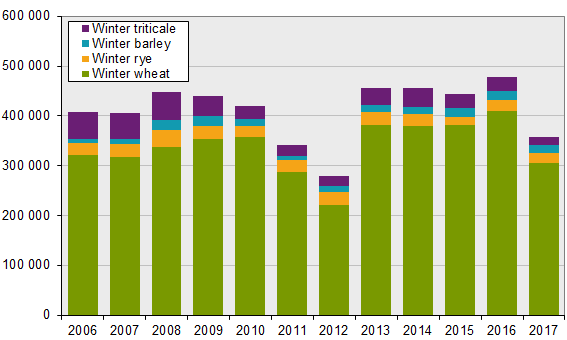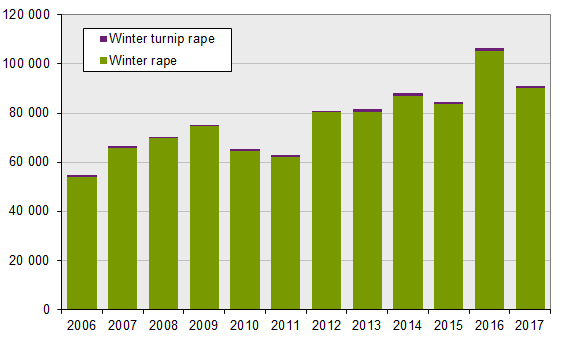Autumn sown areas 2017:
The rainy autumn decreased the winter wheat area
Statistical news from Statistics Sweden and Swedish Board of Agriculture 2017-11-30 9.30
This autumn 306 300 hectares of wheat were sown, which is 25 percent less than last year. Much of the planned sowing had to be cancelled, as the fields could not be cultivated during the rainy autumn.
The decline in autumn sown areas is prevalent in all parts of the country. In Halland and Värmland there was a reduction of the winter wheat area of around 50 percent, compared with last year. In the Skåne County, the winter wheat area decreased by 26 percent. This year's total area of cereals and oilseed crops sown in the autumn amounts to 448 800 hectares. That is 23 percent less than last autumn and 12 percent less than the average for the last five years.
Winter rye and winter barley at the same level as last year's areas
The autumn sown area of rye was 19400 hectares, which is at the same level as last autumn's area. The winter barley area is estimated at 16 500 hectares, which is also in line with last year's area. This can be explained by that fact that winter rye and winter barley need to be sown earlier than winter wheat. Hence, the sowing of these crops was often successful as it in most cases was carried out before the autumn rains started to limit the conditions for cultivation and sowing.
The area with winter triticale was almost halved
The area of winter triticale has been estimated at 15 600 hectares, a decrease of 43 percent compared with the previous year's area and a decrease of 48 percent compared with the five-year average.
The area of winter rape also decreased
The area of winter rape has been estimated at 90 100 hectares, which is 15 percent less than the record area of last year. The winter rape area is now in line with the last five-year average. The area of winter turnip rape is estimated at 900 hectares.
Organically cultivated autumn sowing also decreased
The total autumn sown area that will be cultivated organically amounts to 31 400 hectares, and is thereby 17 percent less than last autumn. The organically cultivated winter wheat area is 18 000 hectares, which is a decrease by 28 percent. The area of winter rape that will be cultivated organically amounts to 7500 hectares, which is at the same level as the record area of last year.
Some areas may need to be resown
The rainy autumn caused difficult conditions for the autumn sowing. There are concerns that the crops that were sown have been damaged by the rain, and must be resown in the spring. There are also reports of slugs, flea beetles and turnip sawfly that have damaged the winter rape.

Note that the tables for cereals and oilseed crops use different scales.

Note that the tables for cereals and oilseed crops use different scales.
Publication
A more detailed report of this survey and results by county and production area is published in the Statistical Report JO 18 SM 1701.
The information is based on a survey where nearly 4 000 farmers submitted information to Statistics Sweden about autumn sown areas.
Feel free to use the facts from this statistical news but remember to state Source: Statistics Sweden.
